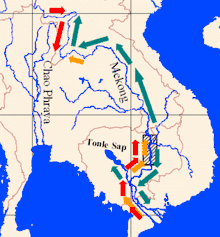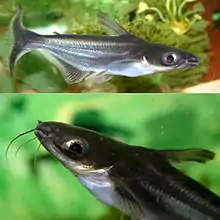Iridescent shark
The iridescent shark (Pangasianodon hypophthalmus) is a species of shark catfish (family Pangasiidae) native to the rivers of Southeast Asia. Despite its name, it is not a shark. It is found in the Mekong basin as well as the Chao Phraya River, and is heavily cultivated for food there.
| Iridescent shark | |
|---|---|
 | |
| Scientific classification | |
| Kingdom: | Animalia |
| Phylum: | Chordata |
| Class: | Actinopterygii |
| Order: | Siluriformes |
| Family: | Pangasiidae |
| Genus: | Pangasianodon |
| Species: | P. hypophthalmus |
| Binomial name | |
| Pangasianodon hypophthalmus (Sauvage, 1878) | |
| Synonyms | |
|
Helicophagus hypophthalmus Sauvage, 1878 | |
The meat is often marketed under the common name swai. It has also been introduced into other river basins as a food source, and its striking appearance and iridescence have made it popular with fishkeeping hobbyists, among whom it is also known as the Siamese shark or sutchi catfish. The swai's omnivorous diet consists of crustaceans, other fish, and plant matter.[3]
Names
The fish is named for the glow or iridescence exhibited in juveniles, as well as the shark-like appearance of this and other shark catfish.
Description
Adults reach up to 130 cm (4.3 ft) in length and can weigh up to a maximum of 44.0 kg (97.0 lb). They have a shiny, iridescent color that gives these fish their name. However, large adults are uniformly grey. The fins are dark grey or black. Juveniles have a black stripe along the lateral line and a second black stripe below the lateral line.[3]
Distribution and habitat

Dark green: May to September
Red: October to February
Shaded region: spawning region of the southern Mekong population between Khone Falls and Kratie
Iridescent sharks originate from the large rivers Chao Phraya and Mekong in Asia, though they have been introduced into other rivers for aquaculture. They are a freshwater fish that natively live in a tropical climate and prefer water with a 6.5–7.5 pH, a water hardness of 2.0–29.0 dGH, and a temperature range of 22–26 °C (72–79 °F).[3] They prefer large bodies of water similar to the deep waters of their native Mekong river basin.
The iridescent shark is a migratory fish that in most regions moves upstream to spawn during the flood season while the waters are high and returns downstream to seek rearing habitats when the river water levels recede. The dates of the migrations vary depending on the river system. In the Mekong river basin, they migrate upstream in May to July and return downstream during September through December. South of the Khone Falls, upstream migration occurs in October to February, with its peak in November to December; here, it appears to be triggered by receding waters at the end of the flood season.[3]
In August 2015, an environmental group in Santander, Colombia, confirmed that iridescent sharks had been found in one of the tributaries that feed into the Magdalena river, having been accidentally introduced from illegal farm fisheries in the area. The find has caused alarm amongst the scientific community and government officials, as the Magdalena river is home to over 200 native fish species, 35 of which are endangered.[4]
Culinary profile

Pangasius does not have a gourmet reputation and is sold cheaply as swai (pronounced /swaɪ/) in the United States, panga (or pangas) in Europe and cream dory and basa in several Asian countries. Basa is also commonly-used in the United Kingdom.
Despite its poor reputation, the total export of pangasius from Vietnam reached US$1.8 billion in 2014.[5]
Pangasius fillets are an increasingly popular product because of their low cost, mild taste and firm texture. Recipes for other whitefish such as sole or halibut can be adapted to pangasius.[6]
Pangasius is an omnivorous fish, and thus does not require a high level of animal protein in its diet. Typical grading sizes are 3–5 oz, 5–7 oz, and 7–9 oz.[7]
In the aquarium

While juvenile iridescent sharks are sold as pets for home aquariums, they are not easy fish to keep. While they can survive in a 40-gallon aquarium, iridescent sharks are schooling fish that prefer groups,[3] are accustomed to living in rivers, and are active fish that require space. They have very poor eyesight, so detected movement from outside of their habitat can be seen as a threat. If stressed, their first instinct is to flee; a blind dash can cause injury in an aquarium environment. These injuries may result in the fish sinking to the bottom, where it may lie on its side or back until it recovers.[8]
Iridescent sharks require a minimum tank size of 12 m (39 ft) to develop naturally. Schools require even larger tanks. If given enough room and fed adequately, they can reach 1 m (3.3 ft) in length. In most home aquaria, the lack of space stunts their growth. For this reason, most iridescent sharks kept in home aquaria grow to 15 to 30 cm (6 to 12 in) in length only and may die prematurely. When provided adequately sized aquaria and proper husbandry, iridescent sharks may live into their teens and grow to full size.[9]
References
- Vidthayanon, C. & Hogan, Z. (2011). "Pangasianodon hypophthalmus". IUCN Red List of Threatened Species. 2011: e.T180689A7649971. doi:10.2305/IUCN.UK.2011-1.RLTS.T180689A7649971.en.
- "Pangasius hypophthalmus". Integrated Taxonomic Information System. Retrieved February 7, 2009.
- Froese, Rainer and Pauly, Daniel, eds. (2012). "Pangasianodon hypophthalmus" in FishBase. February 2012 version.
- "Alerta por amenaza del pez basa en el río Magdalena". El Tiempo. 1 October 2015.
- Thang, Luu Viet. "Sector profile". seafood.vasep.com.vn. Retrieved 2016-02-15.
- VASEP. "The three key steps to restore the image of Pangasius" (PDF). Vietfish International: 88. Archived from the original (PDF) on 2016-02-23.
- "Chef's Resources – Swai Fish Profile". Chefs-resources.com. Retrieved 2012-06-22.
- Axelrod, Herbert, R. (1996). Exotic Tropical Fishes. T.F.H. Publications. ISBN 0-87666-543-1.
- Aqualand Pets
External links
| Wikimedia Commons has media related to Pangasius hypophthalmus. |
| Wikispecies has information related to Pangasius hypophthalmus. |
